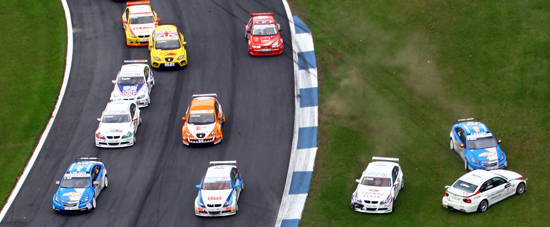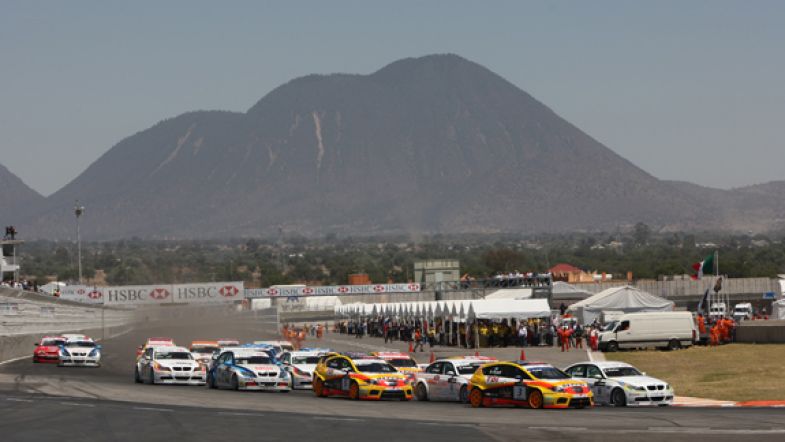A deep look in to the penalty weight system
In previous seasons the WTCC has employed a system of success ballast where drivers would gain weight based on a combination of their current championship position and their results at the previous meeting. Whilst such systems have worked well in other series they have not always been successful in the WTCC.
In part this has been due to the FIA regularly introducing base weight adjustments, performance restrictions and technical waivers in a bid to equalise performance of the various makes and models. These frequent changes were seen by many as unnecessary meddling and often failed to have the desired effect.
For 2009 the WTCC has adopted a new series of success ballast, or compensation weights as it is now know, based the performance of each model. As a result all drivers of a particular model will run with the same weight regardless of their individual results.
The starting point for the calculations is to take the average of the two best lap times from each model during qualification and each of the two races. Taking the first race at Curitiba as an example, the best times in a BMW were 1m25.710s (Farfus) and 1m25.747s (Hernandez) giving an average of 1m25.729s, whilst the best times in a Leon Tdi were 1m25.662s (Muller) and 1m25.760s (Gene) giving an average of 1m25.711s.
Should the second of the two times be more than 0.3s slower that the first then a substitute time of the fastest lap plus 0.3 seconds is used. For Lada the fastest time was Japp van Lagen’s 1m27.241s. His team mate Kirill Ladygin only managed a 1m27.765s so a time of 1m27.541s is used instead (i.e van Lagen’s time + 0.3s)
BMW Leon Tdi Cruze Lada Leon
Time 1 1:25.710 1:25.662 1:25.806 1:27.241 1:26.512
Time 2 1:25.747 1:25.760 1:26.106 1:27.541 1:26.812
Average 1:25.729 1:25.711 1:25.956 1:27.391 1:26.662
The next step is to scale those times based on a target time of 114 seconds, which is calculated by dividing the actual average time by the best average and multiplying by 114. The scaling is done to give a better comparison between the models based on a consistent baseline. The rain affected second race at Curitiba saw the cars around 10s a lap slower but this allows a direct comparison with the earlier race to be made.

Scaling the times also allows for a comparison of the relative performance at different circuits. Without this it would be difficult to compare, for example, the result at Pau (typically a 1m22s lap) with Brno (typically 2m10s).
BMW Leon Tdi Cruze Lada Leon
Actual 1:25.729 1:25.711 1:25.956 1:27.391 1:26.662
Scaled 1:54.012 1:54.000 1:54.326 1:56.234 1:55.265
Once the scaled lap times have been calculated a comparison between each model and the fastest model is made. Should any model be more than 1.5s slower than the fastest model then a maximum difference of 1.5s is used. In this example Lada would have recorded a scaled average of 1m56.234s, some 2.2s slower that the Tdi Leons so an adjusted time of 1m55.500s is used.
BMW Leon Tdi Cruze Lada Leon
Scaled 1:54.012 1:54.000 1:54.326 1:56.234 1:55.265
Adjusted 1:54.012 1:54.000 1:54.326 1:55.500 1:55.265
The same calculations are repeated for Qualifying and each of the two races, giving three times for each model. A weighted average is then calculated taking the two race times plus 1.5x the qualifying time. Weighting the qualifying time in this way is done because qualifying is often a better indication of outright performance than race pace.
The resulting figure is taken as the lap time for that event.
BMW Leon Tdi Cruze Lada Leon
Qualifying 1:54.592 1:54.000 1:54.578 1:55.500 1:55.500
Race 1 1:54.012 1:54.000 1:54.326 1:55.500 1:55.265
Race 2 1:54.148 1:54.146 1:54.000 1:55.304 1:55.435
Average 1:54.303 1:54.042 1:54.341 1:55.444 1:55.414
The same process is repeated after each race meeting, giving a weighted average time for each meeting.
After the second meeting the average of the two results is taken, rounded to the nearest 0.1s. For the remainder of the season the average of the preceding three meetings will be used.
BMW Leon Tdi Cruze Lada Leon
Curitiba 1:54.303 1:54.042 1:54.341 1:55.444 1:55.414
Puebla 1:54.000 1:54.325 1:55.500 1:55.500 1:55.500
Average 1:54.2 1:54.2 1:54.9 1:55.5 1:55.5
Difference 0.0s 0.0s 0.7s 1.3s 1.3s
For each model the difference between the average and the best model will be calculated. Compensation weight is then calculated based on these values. The fastest model starts the next meeting at +40kg over the normal base weight, which is considered to be the maximum compensation weight.

Any model that is within 0.3s of the best time receives no further adjustment and also starts at +40kg. For each 0.1s slower than the best time the model can deduct 10kg up to a maximum of 60kg (i.e. 20kg under base weight).
BMW Leon Tdi Cruze Lada Leon
Difference 0.0s 0.0s 0.7s 1.3s 1.3s
Weight +40kg +40kg 0kg -20kg -20kg
After each meeting the compensation weights are wiped and recalculated based on the new rolling average times.
On the face of it the new weight compensation system involves some fiendishly complicated calculations but offers some real advantages. By starting with real timing data the system is much less subjective than previous methods, whilst the scaled and weighted figures mean that it is easier to judge the relative performance of different models across a range of circuits and conditions.
Predicted Weights for Marrakech
BMW Leon Tdi Cruze Lada Leon
Base Weight 1170kg 1170kg 1170kg 1170kg 1170kg
Compensation +40kg +40kg 0kg -20kg -20kg
Weight 1210kg* 1210kg 1170kg 1150kg 1150kg
* Alex Zanardi carries a further 30kg due to the use of a sequential gearbox.
Update
To prove just how complicated the system is it seems that TCT’s calculations do not agree with the official FIA solution. The Chevrolet Cruize will race at Marrakech with –20kg, not 0kg as we had predicted. Additionally the sequential gearbox in Alex Zanardi’s BMW means that the car is treated as a separate model with a separate weight calculated and also starts Marrakech with –20kg.










